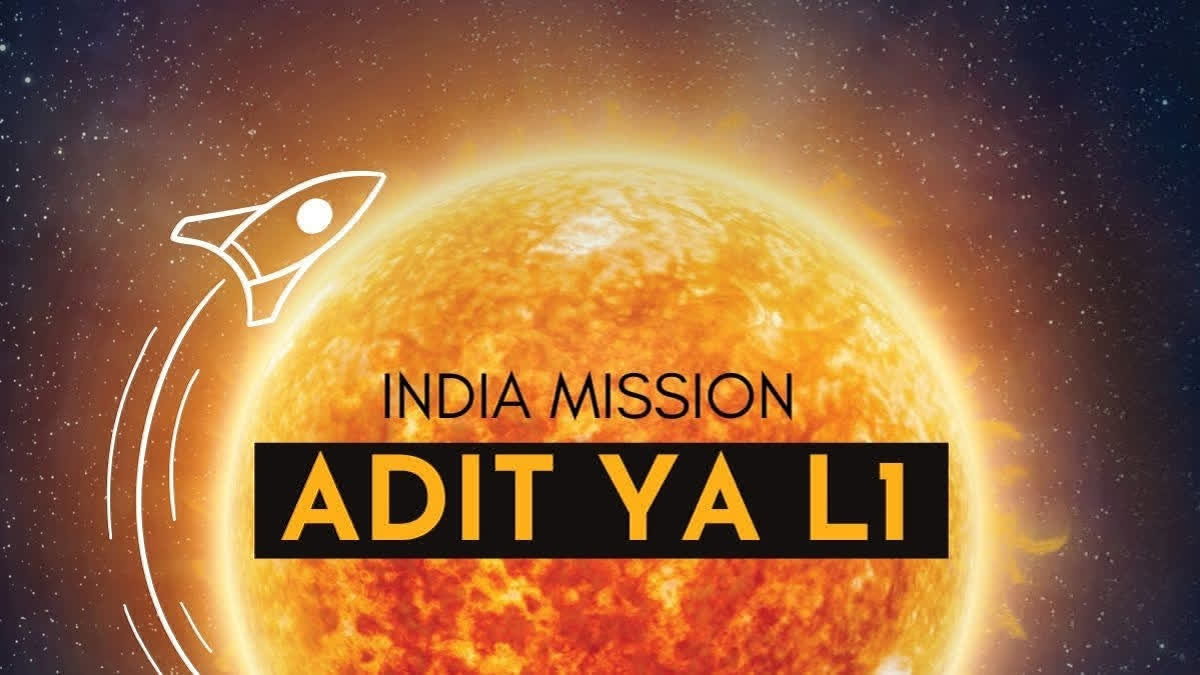Hyderabad: Aditya-L1 mission is India's first space-based solar observatory which has been designed and developed by the Indian Space Research Organisation (ISRO) to study the solar atmosphere and the Sun from a significant distance of 1.5 million km. Apart from this, the mission carries seven payloads (instruments of Aditya-L1 are tuned to observe the solar atmosphere) to orbit to observe the chromosphere, photosphere and outermost layers of the Sun's atmosphere with the help of electromagnetic, particle and magnetic field detectors.
About Aditya L-1 Mission:
The Aditya-L1 mission was successfully launched aboard the PSLV C57 from the Satish Dhawan Space Centre in Sriharikota, Andhra Pradesh, at 11.50 am on September 2, 2023. The Aditya L1 mission will take around 109 Earth days after the launch to reach the halo orbit around the L1 point, which is about 1,500,000 km from the Earth.
The ISRO took to X, formerly known as Twitter, and shared the news of the successful launch of Aditya-L1 by PSLV-C57. "PSLV-C57/Aditya-L1 Mission: The launch of Aditya-L1 by PSLV-C57 is accomplished successfully. The vehicle has placed the satellite precisely into its intended orbit. India's first solar observatory has begun its journey to the destination of Sun-Earth L1 point," the ISRO said.
PM Narendra Modi congratulates ISRO:
Soon after the maiden solar mission launching, Prime Minister Narendra Modi congratulated the ISRO. The Prime Minister appreciated the efforts of scientists and said, "India continues its space journey" after the success of Chandryaan-3 on the Moon. "Our tireless scientific efforts will continue in order to develop a better understanding of the Universe for the welfare of entire humanity," PM Modi said in a post on X.
Experts analyze Aditya L-1 Mission:
The first solar mission has sparked excitement among scientists, including Professor Gopal Hazra and Professor Amitesh Omar, who are eagerly awaiting the data for their research.
ISRO shares images:
On December 8, the ISRO shared the first-ever full-disk images of the Sun in near ultraviolet wavelengths ranging from 200 to 400 nm that were captured by the Solar Ultraviolet Imaging Telescope SUIT (designed to study the solar spectral radiation in the ultraviolet range) payload aboard Aditya L-1 mission.
Sharing the pictures on X, ISRO wrote that the images "provide pioneering insights into the intricate details of the Sun's photosphere and chromosphere. The Solar Ultraviolet Imaging Telescope (SUIT) instrument on board the Aditya-L1 spacecraft has successfully captured the first full-disk images of the Sun in the 200-400 nm wavelength range."
On November 20, 2023, the SUIT payload was powered on and after a successful pre-commissioning phase, the telescope captured its first light science images on December 6, 2023. These unprecedented images were taken using 11 different filters, including the first-ever full-disk representations of the Sun in wavelengths ranging from 200 to 400 nm, excluding Ca II h. The full disk images of the Sun in the Ca II h wavelength were studied from other observatories.
The SUIT instrument captured sunspots, plage, and quiet Sun regions, as marked in the Mg II h image, providing scientists with pioneering insights into the intricate details of the Sun's photosphere and chromosphere. SUIT observations will help scientists study the dynamic coupling of the magnetised solar atmosphere and assist them in placing tight constraints on the effects of solar radiation on Earth's climate.
The SUIT has been developed under the leadership of the Inter-University Centre for Astronomy and Astrophysics (IUCAA), Pune in collaboration with ISRO. Agencies or institutions such as the Manipal Academy of Higher Education (MAHE), the Centre for Excellence in Space Science Indian (CESSI) at IISER-Kolkata, the Indian Institute of Astrophysics Bengaluru, the Udaipur Solar Observatory (USO-PRL), and Tezpur University, Assam were also involved in the development of SUIT.
Orbit raising burns:
- The first orbit raising burn, 3 September 2023: The Aditya-L1 performed its first Earth-bound manoeuvre, raising its orbit to 245 km (152 mi) into 22,459 km (13,955 mi) orbit.
- The second orbit raising burn, 5 September 2023: Aditya-L1 performed its second Earth-bound manoeuvre, raising its orbit to 282 km (175 mi) into 40,225 km (24,995 mi) orbit.
- The third orbit raising burn, 10 September 2023: Aditya-L1 performed its third Earth-bound manoeuvre, raising its orbit to 296 km (184 mi) into 71,767 km (44,594 mi) orbit.
- The fourth orbit raising burn, 15 September 2023: Aditya-L1 performed its fourth Earth-bound manoeuvre, raising its original orbit to 256 km (159 mi) into 121,973 km (75,791 mi) orbit.
- Trans-Lagrangian 1 Injection, 19 September 2023: Aditya-L1 performed its last manoeuvre around Earth to escape its orbit and headed towards the Lagrange 1 point. It will take at least four months to further reach its destination, 1.5 million KM away. On 30 September 2023, Aditya-L1 escaped the Earth’s sphere of influence and was on the way to the Lagrange 1 point.
- Trajectory correction maneuver, 6 October 2023: Aditya-L1 performed a Trajectory Correction maneuvre (TCM1). It was needed to correct the trajectory evaluated after tracking the Trans-Lagrangian Point 1 Insertion (TL1I) manoeuvre performed on 19 September 2023
Read more:
- Year-ender 2023: What is future of Russia's lunar mission after its Luna 25 spacecraft crashes
- Year-ender 2023: Sinking Joshimath hill town remains a ticking time bomb
- Year-ender 2023: India pulls off a successful mountainous feat in Silkyara Tunnel Rescue
- Year-ender 2023: India’s G20 Presidency characterised by spearheading solutions for global prosperity
- 2023 year-ender: When Manipur violence rocked the nation, streets and the Parliament
